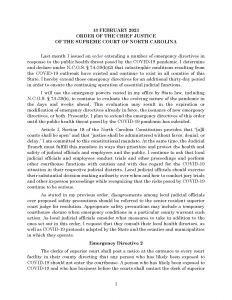Chief Justice Newby’s latest order extending emergency directives issued in response to the COVID-19 pandemic became effective on Saturday. This post reviews the order and the directives therein, which have been extended for 30 days.
The preamble. Chief Justice Newby stated that his ongoing evaluation of the pandemic might result in the expiration or modification of emergency directives, the issuance of new directives, or both. His current plan is to extend the emergency directives that are currently in place until the public health threat posed by the COVID-19 pandemic has subsided. The Chief Justice reiterated his commitment to the state constitutional requirement that courts be open and that justice be administered without favor, denial, or delay.
The directives. The order, entered February 12 and effective February 13, extends Emergency Directives 2, 3, 5, 8, 11, 12, 14, 15, and 21 for 30 days. All of the directives were renewed without any substantive modification.
Emergency Directive 2. This directive requires the posting of notices at court facilities directing that any person who has likely been exposed to COVID-19 should not enter the courthouse.
Emergency Directive 3. This directive authorizes judicial officials to conduct proceedings that include remote audio and video transmissions. Remote proceedings must safeguard a defendant’s constitutional rights to confrontation and to presence, maintain required confidentiality, be recorded when required, and allow parties to communicate fully and confidentially with their attorneys.
Emergency Directive 5. This directive permits verification of pleadings and other documents by affirmation of the subscriber.
Emergency Directive 8. This directive provides that magistrates must continue to perform marriage ceremonies in suitable locations approved by the chief district court judge. The chief district court judge may restrict the hours and times at which marriage ceremonies are conducted.
Emergency Directive 11. This directive requires each senior resident superior court judge to serve as or designate a COVID-19 Coordinator for each facility in his or her district. The COVID-19 Coordinator must ensure that relevant safety protocols and mandates are followed in court facilities.
Emergency Directive 12. This directive requires each senior resident superior court judge to ensure that certain public health protocols (including the marking of six foot intervals, the establishing of maximum occupancy, and the cleaning of public areas) are followed for each facility in his or her district.
Emergency Directive 14. This directive permits clerks to require that filings be submitted using a secure drop box and that access to public records be provided by appointment.
Emergency Directive 15. This directive encourages attorneys and litigants to submit filings by mail and provides that documents delivered by U.S. mail are deemed timely filed if received within five business days of the due date. The extension of filing deadlines does not apply to filings in proceedings for forfeiture of bail bonds.
Emergency Directive 21. This directive requires all persons in a court facility to wear a face covering while they are in common areas and when they are or may be within six feet of another person. A face shield may be used in addition to, but not as a substitute for, a face covering.
The face-covering requirement does not apply to persons who:
- cannot wear a face covering for health or safety reasons,
- are actively eating or drinking,
- are communicating with someone who is hearing-impaired in a way that requires the mouth to be visible,
- are temporarily removing their face covering to secure medical services or for identification purposes,
- who are complying with a directive from law enforcement or courthouse personnel, or
- are under five years old.
A judicial official presiding over a trial or proceeding may order a juror answering questions during voir dire, an affiant, or a testifying witness to remove his or her face covering so that the person’s facial expressions may be observed. A juror’s, affiant’s, or witness’s face covering may only be removed for this purpose while the person is speaking and only if he or she is at least six feet away from any other person.
A presiding judge also may, upon a showing of good cause and after considering all appropriate health concerns, exempt a defendant in a criminal case from the face covering requirement during the defendant’s jury trial.
Expiration. The Emergency Directives in the February 13, 2021 order expire on March 14, 2021.
A comprehensive chart. My colleague, Meredith Smith, has been maintaining a reference chart (available here) that is helpful in keeping track of the directives.